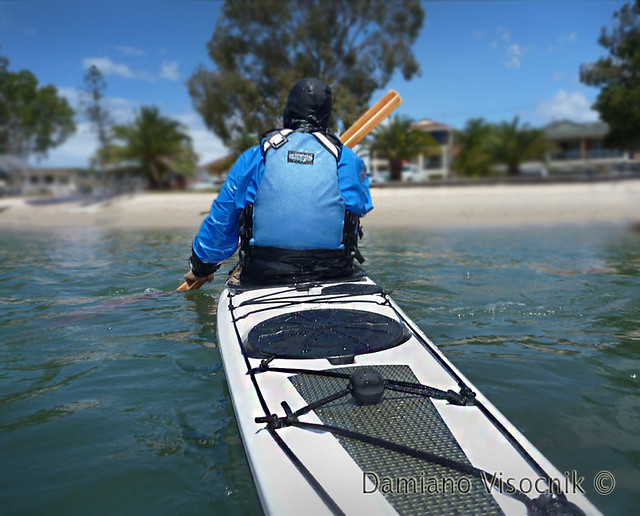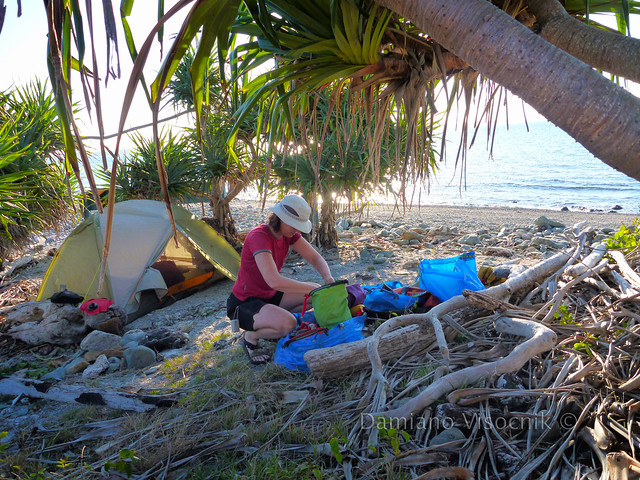The local importer had several new (to Australia) sea kayaks available for testing but the Zegul 520 definitely caught my eye over the 530 and the 550 models aimed towards the "need for speed" crowd.
Its profile resembles a more traditional kayak (so called Greenland lines) with a healthy overhanging bow.
With possibly a more pronounced upturned ends than the typical skin on frame kayak that I have seen, the hull appeared to have a considerable rocker in its keel.
The bow and stern are not as fine as the Tahe Greenland (also on offer at the demo) as there is more volume in those areas.
Actually the whole kayak is more "chunky" than the super-sleek looking Greenland.
With its generously long keyhole cockpit I could seat "bum first, legs later", even with my rather long legs.
The coaming slopes aggressively from high up front to pretty low on the back (I had no chance to get those measurements...).
Compared to the Greenland T, the front was substantially higher and the rear probably an inch higher.
Looking at the profile of the cockpit it had good credentials to be a "comfortable" low rear-deck kayak.
My quick compression test (the good old fashioned: press with my hand on the deck and hull) revealed that this kayak's lay-up had a bit more substance than the alarmingly soft deck of some other "glitter finish" British offerings :-)
The hull is a very solid carbon/Kevlar weave that is vacuum infused .
The finish is superb, inside and out.
The rear deck has a very clever profile that despite looking flat gives the surface an very positive support for possible over the deck reentry (not that you would on such a narrow high end kayak) and did not flex when I sat on it.

Initially I was sceptical about the third hatch in front of the cockpit: my experience with another British boat with that design was not positive.
But, on the Zegul, it proved to be out of the way of my knees and just big enough to store small items (compact camera, snack, towrope etc.)
The seat was a bit on the narrow side (may I say that my ass ain't size 30....).
I didn't like the configuration of the backband anchor point inboard, on the seat pan.
I would move it to the exterior of the pan and have a smooth surface with no plastic protruding into my hips.
The Zegul 520 trialled was an LV (low volume) version.
My thighs were just getting pinched at the start of the thigh braces.
I think I would fit the HV version better.
Kudos to Zegul (Tahe) for identifying that one size does not fit all body types and having two deck versions of the same hull.

Greg balance bracing Zegul 520 LV
How did it behave on the water?
Better than expected.
Where you expecting it to behave bad?
Well, not really, but hopping in a new boat that is considerably narrower than my current kayaks, I was expecting the initial stability to be a bit more tender.
Interestingly enough Vanilla found the Zegul not as stable as I did.
Admittedly I thought it was a bit more tippy than the Tahe Greenland but I still felt confident to let go of the paddle and relax.
It will be interesting to see how the Zegul behaves in textured waters.
The low deck allowed me to lay on the back of the deck (with PFD) without lifting my bum out of the seat: great.
Finally a kayak that fits my legs and allows lay-backs.
The Zegul appeared to track straight (short test paddle with very little wind) and could be turned relatively sharp with a gentle sweep stroke and edging. The hard chined hull allows for precise maneuvering and correction of direction by dropping and edge, something that my round hulled kayak does not.
I felt a solid secondary stability and could drop the seam of the deck lower into the water than usual, without going over.
The Zegul shined when rolled: really.
With my limited rolling skills I could perform very slow Greenland layback rolls, something that I can't do too well in my high decked kayaks.
Skulling was a breeze, to the point of falling into a static brace with little effort.
The cockpit is roomy enough to allow my body to twist and my legs to move and apply pressure onto the deck to rotate the hull.
When I asked Greg Schwarz to briefly test the Zegul I just watched in awe the beautiful moves he could perform.
Then again Greg looks good in just about any kayak.
select 360p (not 720p) if you have slow internet connection
The Zegul 520 is a strong contender in my search for that elusive "Greenland style" kayak that would fit my non slender figure.
The quality of construction is impeccable and with the considerable lower price than the British competitors Tahe has brought to the masses a fantastic line-up of new kayaks.
PS FEB2011: I have added a Zegul 520 HV to my fleet and after a few paddles I have modified the cockpit set up. Details of the new seating arrangement coming soon...







